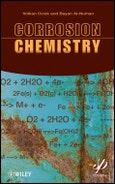Corrosion is in essence a chemical process, and it is crucial to understand the dynamics from a chemical perspective before proceeding with analyses, designs and solutions from an engineering aspect. This book can be used both as a textbook and a reference book both by academics and engineers and scientists in the field.
As a reference for the engineer in the field, it is both a refresher for the veteran on the causes of corrosion and the methods, processes, and technologies to deal with it, over a variety of industries. It is the most up-to-date, comprehensive treatment of corrosion available, covering the most cutting-edge new processes and theories. For the freshman engineer just entering the field, it is a tremendous introduction to corrosion.
As a textbook, it can be used for a single semester technical elective course in undergraduate and postgraduate education for disciplines such as chemistry, chemical engineering, petroleum engineering, civil engineering, material engineering, mechanical engineering, metallurgical engineering, mining engineering, agricultural engineering, and other related technical fields.
Table of Contents
List of tables ixAcknowledgements xi
Preface xiii
1. Corrosion and Its Definition 01
2. The Corrosion Process and Affecting Factors 03
3. Corrosion Types Based on Mechanism 07
3.1 Uniform Corrosion 07
3.2 Pitting Corrosion 08
3.3 Crevice Corrosion 09
3.4 Galvanic Corrosion 10
3.5 Intergranular Corrosion 11
3.6 Selective Corrosion 12
3.7 Erosion or Abrasion Corrosion 12
3.8 Cavitation Corrosion 12
3.9 Fretting Corrosion 13
3.10 Stress Corrosion Cracking 13
3.11 Microbial Corrosion 13
4. Corrosion Types of Based on the Media 15
4.1 Atmospheric Corrosion 15
4.2 Corrosion in Water 18
4.3 Corrosion in Soil 20
5. Nature of Protective Metal Oxide Films 23
6. Effect of Aggressive Anions on Corrosion 27
7. Corrosion Prevention Methods 31
8. Commonly Used Alloys and their Properties 33
8.1 Aluminum 2024 Alloy 35
8.2 Aluminum 7075 Alloy 36
8.3 Aluminum 6061 Alloy 36
9. Cost of Corrosion and Use of Corrosion Inhibitors 39
10. Types of Corrosion Inhibitors 43
10.1 Anodic Inhibitors 44
10.2 Cathodic Inhibitors 44
11. Chromates: Best Corrosion Inhibitors to Date 47
11.1 Limitations on the Use of Chromates due to Toxicity 48
11.2 Corrosion Inhibition Mechanism of Chromates 53
12. Chromate Inhibitor Replacements: Current and Potential Applications 57
12.1 Nitrites 58
12.2 Trivalent Chromium Compounds 59
12.3 Oxyanions Analogous to Chromate 59
12.4 Synergistic Use of Oxyanions Analogues of Chromate 66
13. Sol-Gels (Ormosils) as Chromate Inhibitor Replacements: Properties and Uses 69
13.1 Types of Sol-Gel s 69
13.1 Types of Sol-Gels 70
13.2 Corrosion Inhibition Mechanism of Sol-Gel Coatings 72
13.3 Synthesis of Sol-Gels 75
13.4 Incorporation of Corrosion Inhibitive Pigments to Sol-Gel Coatings 77
14. Corrosion in Engineering Materials 81
14.1 Introduction 81
14.2 Steel Structures 82
14.3 Concrete Structures 85
14.4 Protection against Corrosion in Construction 95
14.5 Corrosion of Unbonded Prestressing Tendons 116
14.6 Cathodic Protection 120
14.7 Corrosion in Industry Projects 135
References 145
Index 173








